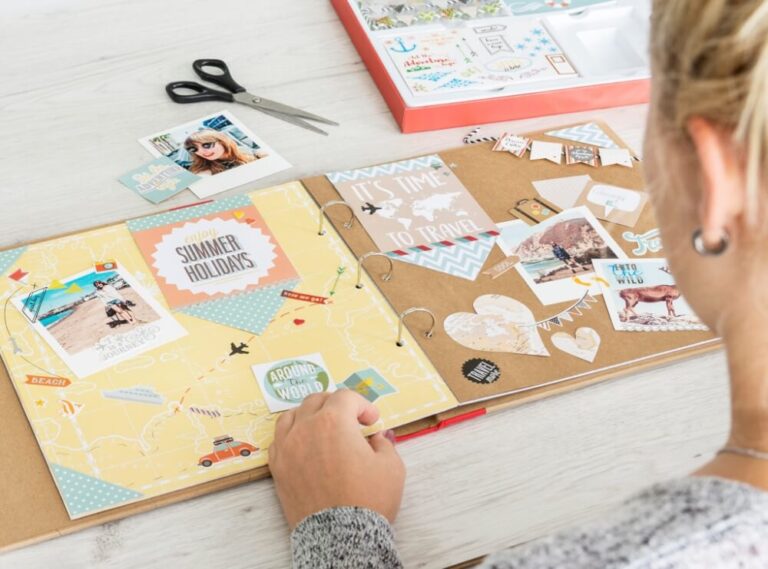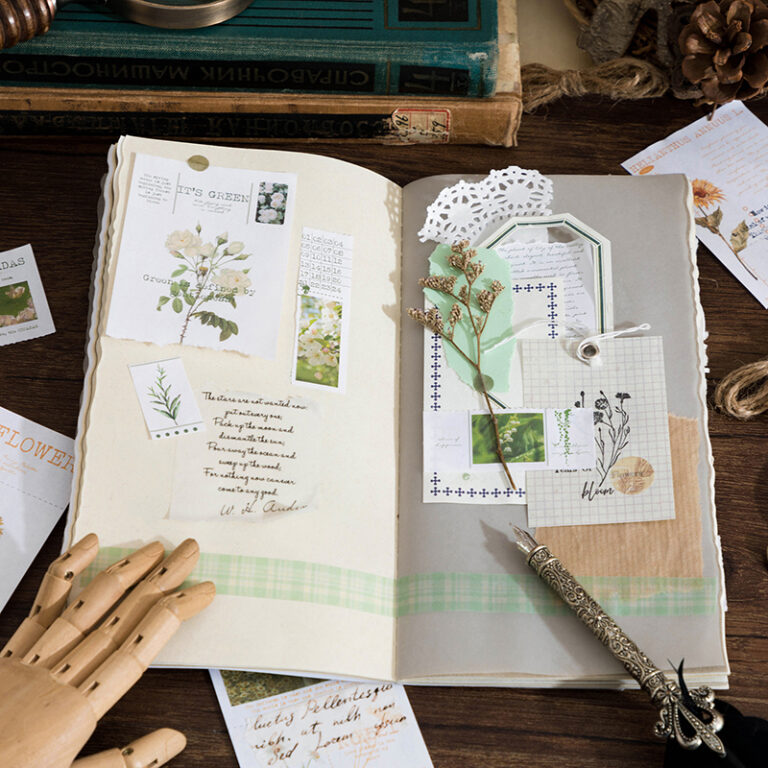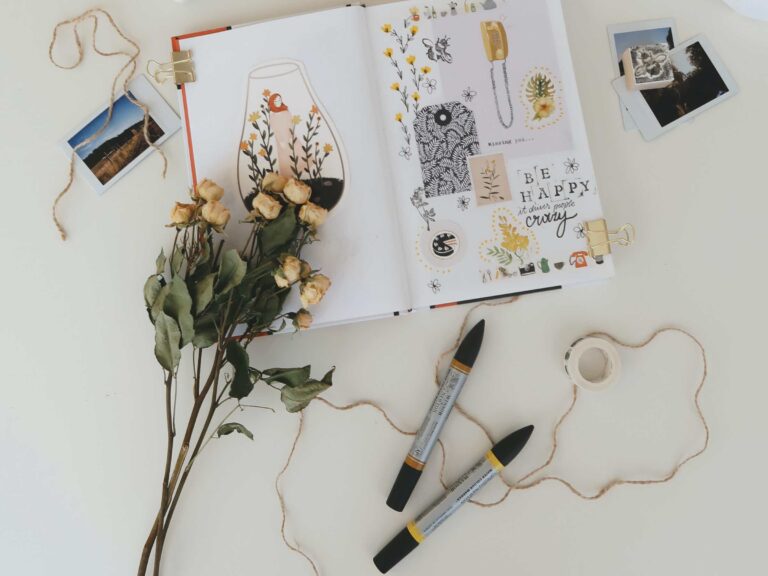Creative Recycling: Reusing Materials in Your Scrapbooking Projects
Creative recycling has become an increasingly popular practice, not only as a way to reduce environmental impact, but also as a way to add a unique and personal touch to projects. One area where creative recycling has stood out is in the world of scrapbooking. Reusing materials in scrapbooking projects not only contributes to preserving the environment, but also adds a unique and memorable dimension to your creations.
Table of Contents
What is Scrapbooking?
Scrapbooking is a form of artistic expression that combines photography, design and storytelling. It involves creating memory albums that capture special moments, events and experiences. At the heart of scrapbooking is the idea of preserving memories in a creative and meaningful way.
How to Awaken the Creative Process in Scrapbooking?
Awakening the creative process in scrapbooking can be a rewarding and inspiring experience. Here are some tips to spark your creativity when working on scrapbooking projects:
- Visual Inspiration :
- Start by researching other scrapbooking creations. Explore magazines, blogs, social media, and scrapbooking books for ideas and visual inspiration. This can help spark your creativity.
- Create an Inspiring Space :
- Set up an organized and inspiring scrapbooking space. Having all your materials on hand makes it easier to start a project when inspiration strikes.
- Use Meaningful Photos :
- Choose photos that have personal or emotional meaning for you. Powerful photos can inspire the storytelling and design of your pages.
- Define a Theme or Story :
- Having a specific theme or story in mind can direct your creativity. It could be a special event, a memorable trip or even a narrative from your life.
- Try New Techniques :
- Be willing to try scrapbooking techniques you’ve never tried before. This may include stamping, embossing, decoupage, watercolor, among others.
- Mix and Match Elements :
- Don’t be afraid to mix different materials, textures and styles on your pages. Sometimes the unexpected combination of elements can lead to surprising results.
- Choose Colors Carefully :
- The color palette you choose can have a big impact on the final look of your project. Consider the emotions and atmosphere you want to convey with colors.
- Search and Learn :
- Learn about scrapbooking techniques, available materials and current trends. Knowledge can open doors to creativity.
- Start with a Sketch or Plan :
- Sometimes it’s helpful to start with a rough outline or plan for your pages. This can give your creativity structure.
- Creative Photography :
- Explore creative photography by taking photos from different angles, playing with light and shadow, and experimenting with composition. Unique photos can be the starting point for memorable projects.
- Join Scrapbooking Groups :
- Join local or online scrapbooking groups or communities. Sharing ideas and receiving feedback from other enthusiasts can be very inspiring.
- Keep an Idea Journal :
- Keep a diary or notebook where you write down your ideas, sketches and inspirations whenever they arise. This can be useful when you are looking for new projects.
- Don’t be afraid to make mistakes :
- Remember that scrapbooking is a personal and creative expression. Don’t be afraid to make mistakes. Sometimes mistakes can lead to creative discoveries.
- Take Time to Relax :
- Creativity often flows when you are relaxed and under no pressure. Take time to relax and allow ideas to come naturally.
Remember that creativity in scrapbooking is an ongoing journey. Take your time and enjoy the creative process. Each scrapbook page is an opportunity to tell a unique story and express your own creativity.
The Importance of Creative Recycling
Creative recycling involves using previously used materials in new contexts and projects. It is a sustainable approach that reduces the amount of waste and contributes to the conservation of natural resources. When applied to scrapbooking, creative recycling offers a unique opportunity to transform everyday items into surprising design elements.
Creative recycling plays a significant role in scrapbooking and can add a special dimension to this hobby. Here is the importance of creative recycling in the context of scrapbooking:
- Environmental Sustainability : Creative recycling in scrapbooking involves using recycled or repurposed materials, such as old wrapping paper, product packaging, scraps of fabric, and more. This helps reduce waste and minimize environmental impact, promoting sustainability.
- Saving Resources : By reusing materials that would otherwise be discarded, you save natural resources such as trees (for paper production) and water (in the manufacturing process).
- Originality and Personalization : Creative recycling allows you to create truly unique scrapbook pages. By incorporating recycled materials, you add authentic and unique elements to your creations.
- Creative Expression : Working with recycled materials can stimulate creativity as you need to find innovative ways to use these resources effectively in your scrapbooking.
- Creative Challenge : The restriction of working with recycled materials can be a fun challenge. This encourages the search for creative solutions and the development of new techniques.
- Inspiration for Others : By demonstrating how you can create beautiful scrapbook pages with recycled materials, you can inspire others to adopt more sustainable practices in their own creations.
- Environmental Awareness : Creative recycling in scrapbooking can be an effective way to raise awareness about the importance of recycling and preserving the environment. Your creations can serve as a visual example of this commitment.
- Community Fostering : The scrapbooking community can also benefit from creative recycling. Scrapbooking groups and clubs can hold recycling-based events or challenges, promoting collaboration and sharing of ideas.
- Versatility of Materials : Creative recycling allows you to experiment with a wide variety of materials, from cardboard and newspapers to old clothing and household objects. This expands your design options.
- Sense of Accomplishment : When you complete a scrapbooking project that incorporates recycled materials, you can feel a deep sense of accomplishment, knowing that you have created something beautiful and meaningful while contributing to protecting the environment.
In short, creative recycling plays an important role in scrapbooking, making it more sustainable, unique and rewarding. It not only helps reduce waste, but also enriches the creative experience and contributes to environmental awareness. So consider incorporating recycled materials into your scrapbooking projects and inspire others to do the same.
Reusing Materials in Scrapbooking Projects
Newspapers and magazines
Old newspapers and magazines can be a rich source of interesting images, words and textures for your scrapbooking projects. Magazine pages can be cut out to create unique collages, while headlines and words can add context and meaning to your pages.
Boxes and Packaging
Product packaging can be transformed into beautiful design elements. Cardboard boxes can be cut and folded to create mini albums or envelopes to hold special keepsakes. Additionally, labels and packaging tags can be used as embellishments on your scrapbooking pages.
Fabrics and Old Clothes
Colorful and patterned fabrics add texture and depth to your scrapbooking creations. You can reuse scraps of fabric from old clothing, scarves, or scraps to create interesting backgrounds or add decorative details to pages.
Buttons, Zippers and Accessories
Vintage buttons, zippers, buckles and other accessories can be uniquely incorporated into your scrapbooking projects. They can act as focal points on your pages or be used to create decorative borders.
Leftover Scrapbooking Paper
Don’t throw away your scrapbooking paper scraps! Instead, use them to create layers, cutouts, and frames. Small pieces of paper can be creatively combined to add depth and dimension to your pages.
Old Cards and Invitations
Cards and invitations received on special occasions can be reused to add a personal touch to your scrapbooking projects. Not only do they evoke memories, they also add a real, tangible element to your pages.
Tips for Incorporating Creative Recycling into Your Projects
- Planning : Before starting a scrapbooking project, take the time to collect and organize the recycled materials you want to use. This will help you visualize how elements will fit on your pages.
- Coherence : Although creative recycling involves using a variety of materials, it’s important to maintain a certain visual coherence across your pages. Choose a color scheme or theme that ties the different elements together.
- Cleaning and Preparation : Some recycled materials may need cleaning or preparation before being incorporated into your project. Remove waste and ensure materials are in good condition.
- Experimentation : Don’t be afraid to experiment and test different combinations of materials. Sometimes the most surprising results come from bold, creative attempts.
- Layers and Dimension : Creative recycling gives you the opportunity to add layers and dimension to your pages. Use recycled materials to create reliefs, textures and three-dimensional effects.
- Meaningful Stories : When choosing recycled materials for your projects, opt for those that have personal meaning or that relate to the story you are telling in your pages.
Conclusion
Creative recycling brings a sustainable and innovative approach to the world of scrapbooking. By reusing materials in your projects, you not only contribute to reducing waste, but you also add a unique and personal element to your creations. Newspapers, packaging, fabrics, buttons and a variety of other materials can find new life in your scrapbooking pages. The next time you sit down to create, consider incorporating creative recycling into your projects and discover the exciting possibilities it offers.
In a world where concern for the environment and sustainability are increasingly crucial, the practice of creative recycling stands out as an intelligent and meaningful approach. In this article, we explore the importance of incorporating recycled materials into scrapbooking projects. We discovered that this approach not only contributes to preserving the planet by reducing waste, but also enriches the creative experience, making it unique and full of inspiring challenges.
Creative recycling in scrapbooking is not just about creating beautiful and meaningful albums, but also about promoting environmental awareness and inspiring others to adopt more sustainable practices in their creative lives. By choosing to reuse materials, we are not only preserving memories, but also preserving our planet for future generations.
As we continue to explore the intersection between art and environmental responsibility, creative recycling in scrapbooking stands out as a powerful way to express our creativity while honoring the world we share. So the next time you embark on a scrapbooking project, consider giving the materials a second life and thus leaving a lighter footprint on the planet. Your creations, full of beauty and purpose, will be a living testimony to the magic of creative recycling.







